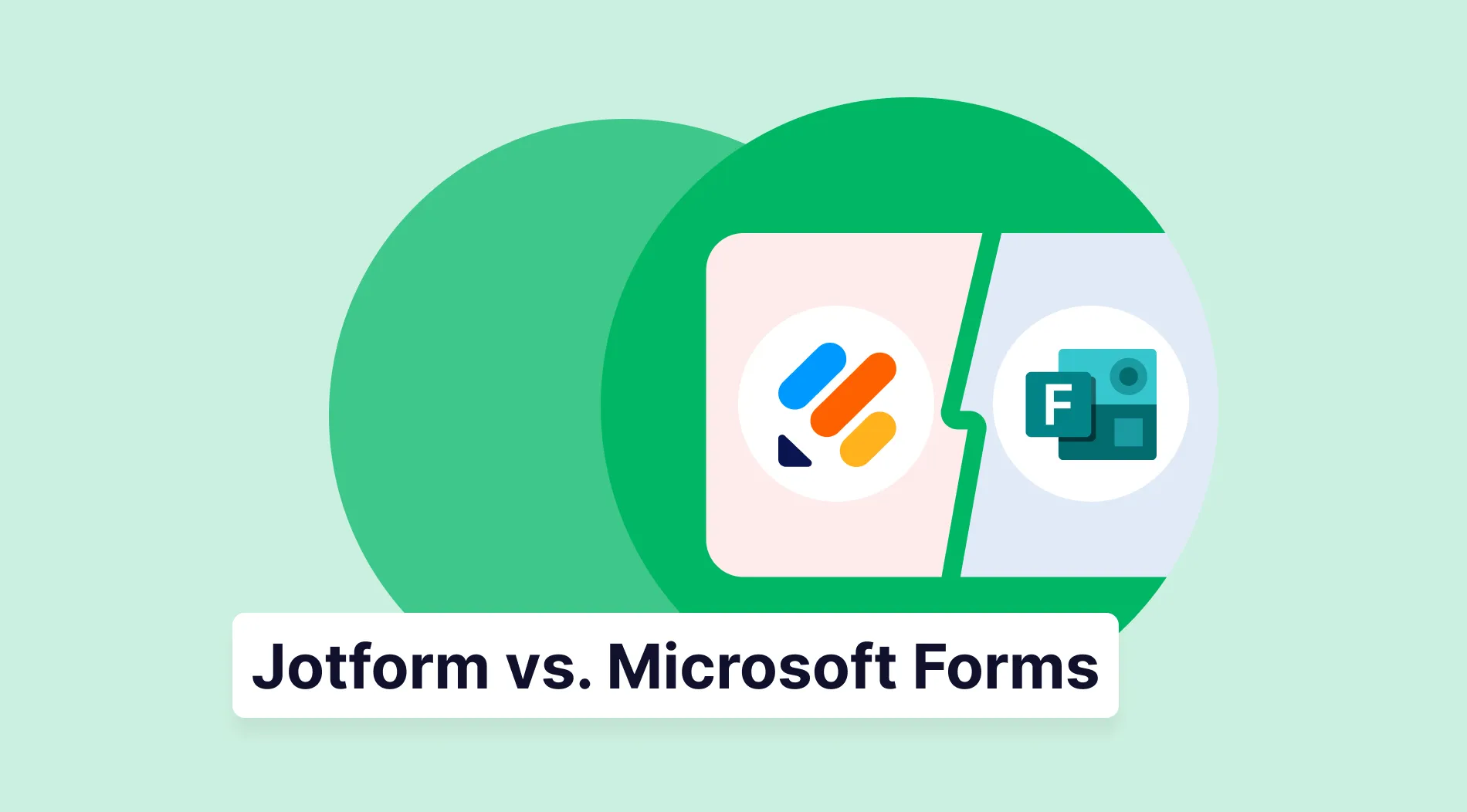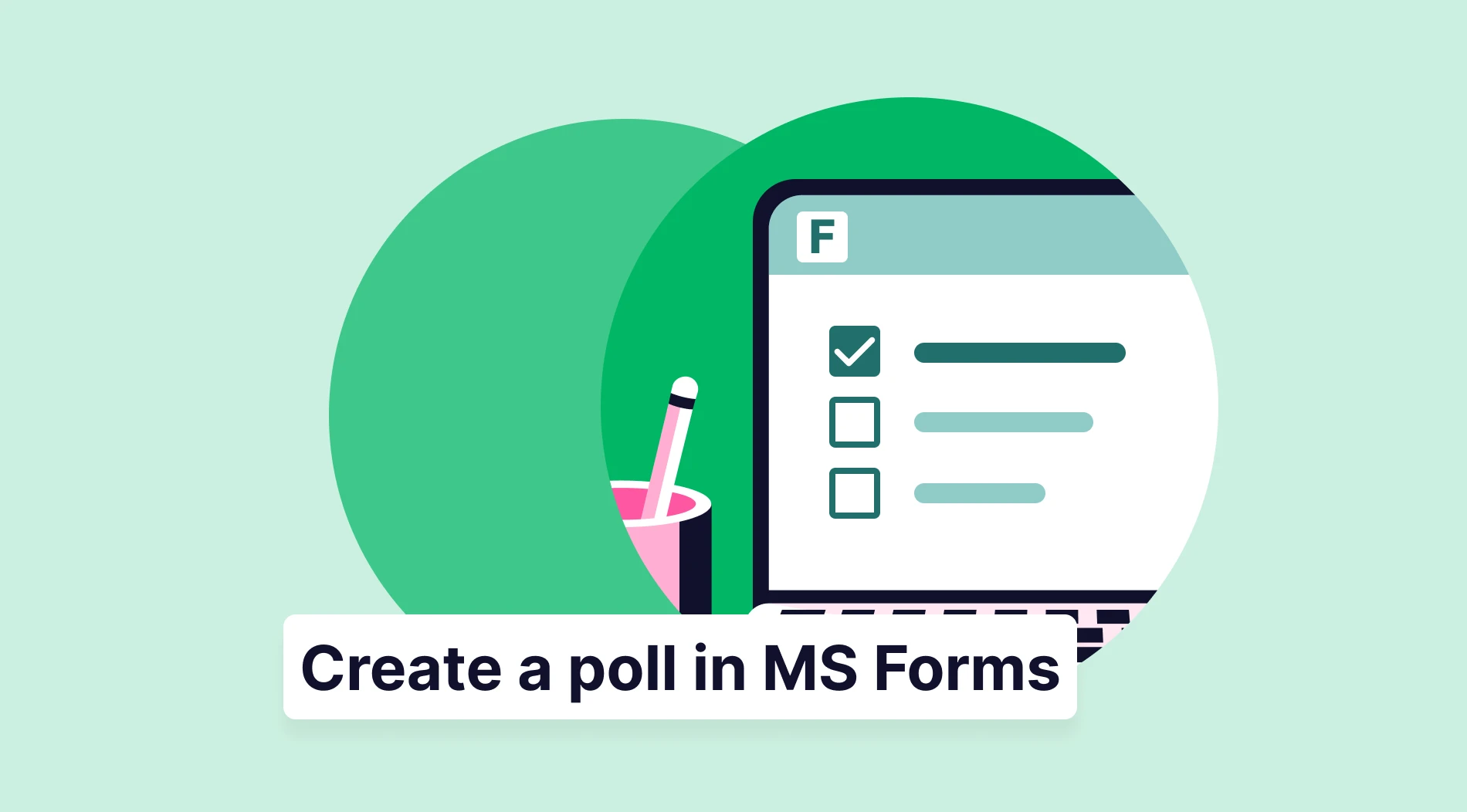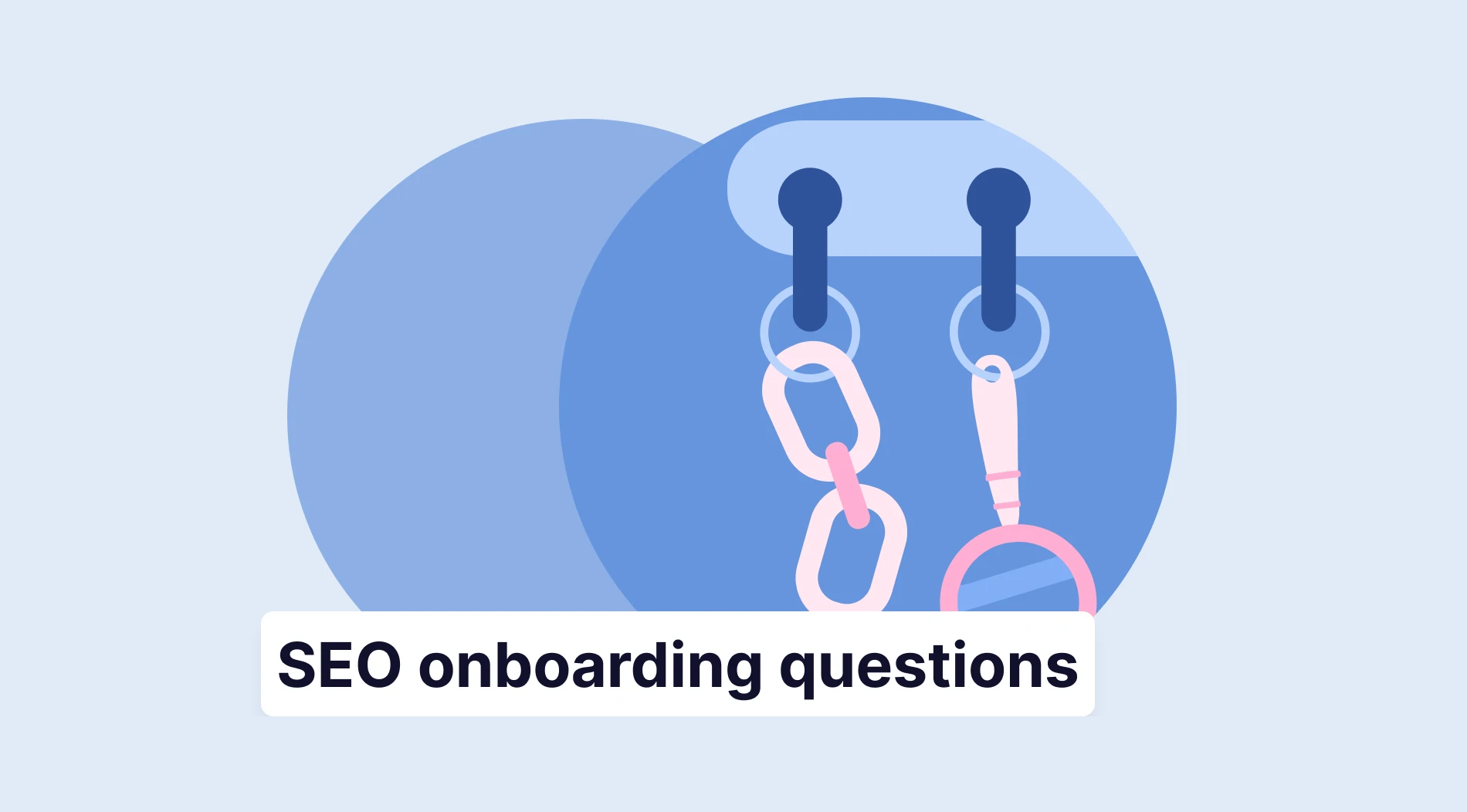Businesses and individuals require efficient form-building tools to manage data collection and feedback. Two popular options are Jotform and Microsoft Forms. Both offer powerful features, but they cater to different needs, making it essential to choose the right one for your specific requirements. Whether you’re looking for extensive customization or seamless integration with other platforms, this article will help you decide.
If you’re feeling overwhelmed or unsure about choosing the right form builder for your needs, don’t worry. In this article, we’ll break down the key differences between Jotform and Microsoft Forms to help you make a decision. We’ll also introduce an alternative that offers powerful features and flexibility, making it a top choice for businesses of all sizes.
Jotform vs. Microsoft Forms at first glance
At first glance, Microsoft Forms vs Jotform both present user-friendly form-building tools with a range of customization options and useful integrations. Jotform stands out with its comprehensive feature set and variety of templates, while Microsoft Forms is known for its straightforward interface and seamless integration with Microsoft’s suite of tools.
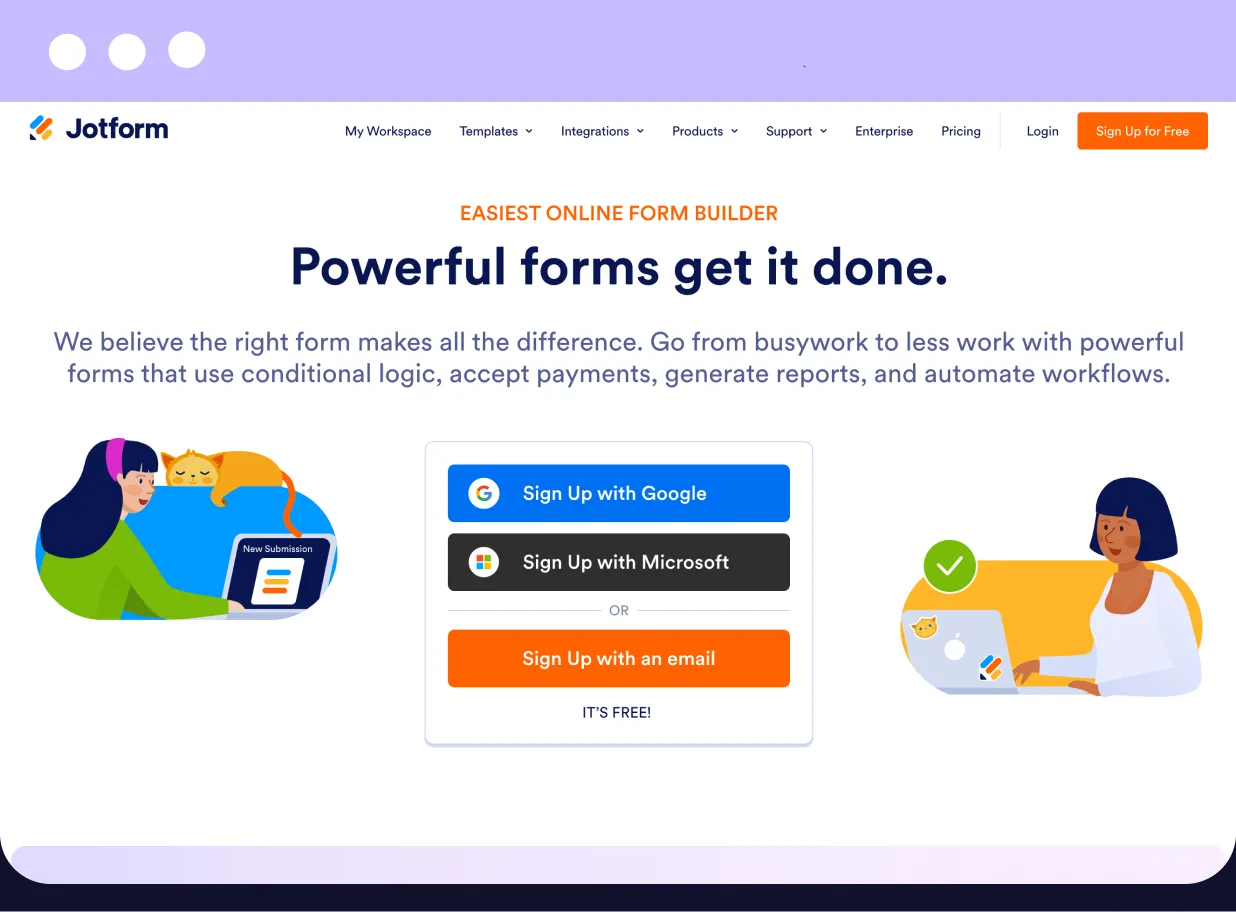
The Homepage of Jotform
Jotform is well-known for its flexible drag-and-drop interface, enabling users to build forms by adding elements such as text, images, widgets, and payment gateways. With an extensive library of form templates and a wide range of customization options, it’s a reliable choice for businesses. Jotform’s robust e-commerce features, including seamless integration with payment processors, make it an ideal fit for businesses seeking to streamline their operations, regardless of size or industry.
🎯 If you are interested in alternatives to Jotform, read this article: Jotform alternatives

The Homepage of Microsoft Forms
Microsoft Forms offers a simple, easy-to-use interface, making it quick to create surveys, quizzes, and forms. It integrates seamlessly with Microsoft 365, which is perfect for teams already using the platform. While its customization options are basic, the ease of use and direct integration with tools like Excel and Teams make it a solid choice for businesses focused on internal data collection and collaboration.
🎯 If you are interested in alternatives to Microsoft Forms, read this article: Microsoft Forms alternatives
Jotform vs. Microsoft Forms: 7 Essential points
Choosing the best form builder involves several important factors, including pricing, features, integrations, and how well it supports team collaboration. To help you decide, we’ve highlighted 7 key areas of comparison between Jotform, Microsoft Forms, and forms.app, giving you a clear overview of what each platform has to offer.
1. Pricing
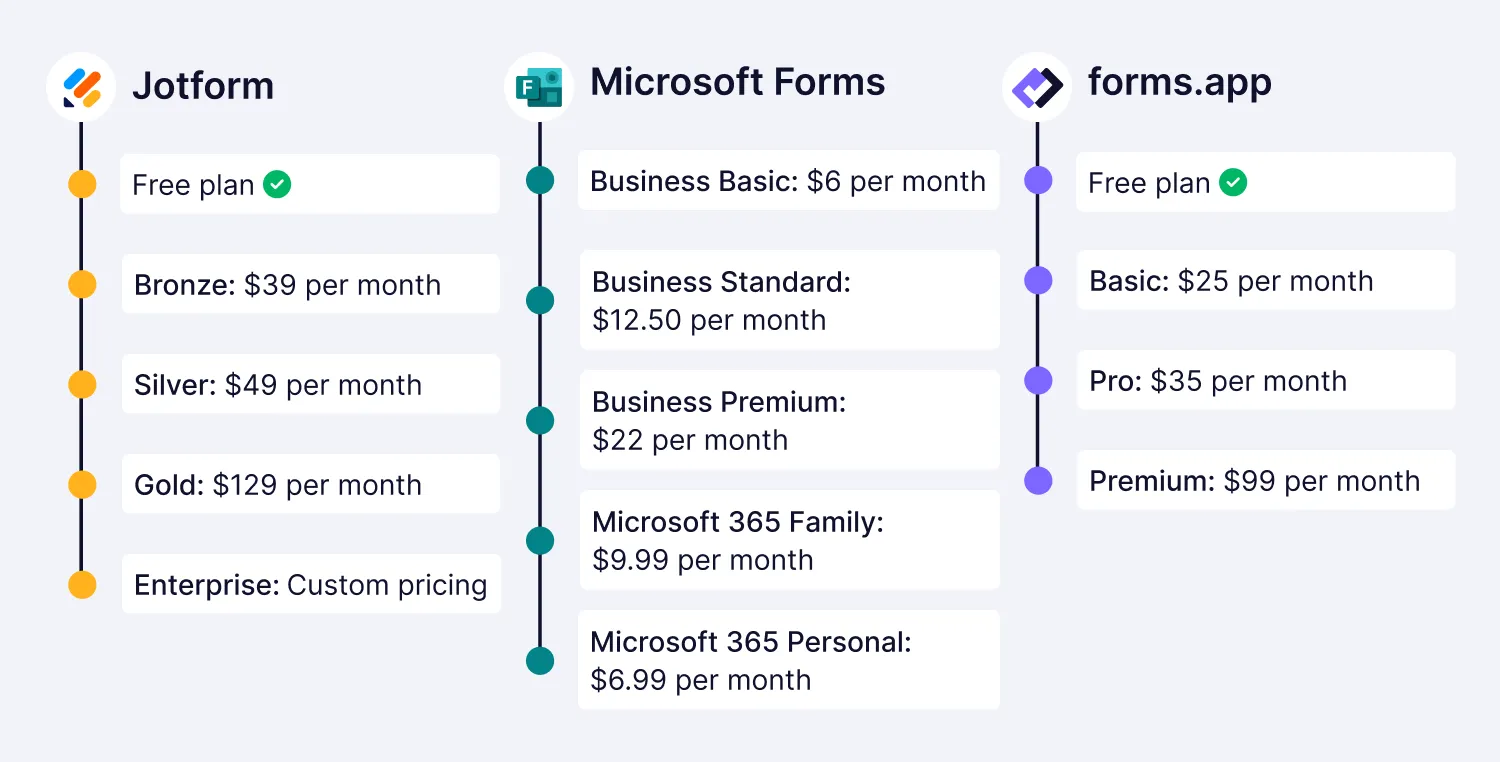
Pricing comparison between Jotform, MS Forms, and forms.app
Jotform offers various pricing plans, starting with a free plan for basic form creation. Paid plans begin at $34 per month for the Bronze plan. The Silver plan costs $39 per month and is suitable for growing businesses, while the Gold plan at $99 per month offers advanced features for larger teams. For custom solutions, Jotform also has an Enterprise plan with tailored pricing. Here’s a summary of Jotform’s pricing plans:
- Free Plan ✅
- Bronze: $39 per month
- Silver: $49 per month
- Gold: $129 per month
- Enterprise: Custom pricing
Microsoft Forms is accessible for free, requiring only a Microsoft account. However, you need to be prepared for its limitations. For business purposes, Microsoft 365 Business plans offer access to Word, Excel, and Outlook. Microsoft Forms is available on all premium plans except for Microsoft 365 Apps for Business. Here are all of Microsoft Forms’ pricing plans:
This platform is free to use ✅
Microsoft 365 plans for business (billed annually only)
- Business Basic: $6 per month
- Business Standard: $12.50 per month
- Business Premium: $22 per month
Microsoft 365 plans for home
- Microsoft 365 Family: $9.99 per month
- Microsoft 365 Personal: $6.99 per month
forms.app, as a top alternative, offers competitive pricing with comprehensive features. Even the free plan includes essential tools such as access to all field types, templates, and integrations. Starting at just $25 per month, forms.app is a cost-effective option compared to Wufoo and Paperform. Here’s a breakdown of forms.app's pricing plans:
- Free Plan ✅
- Basic Plan: $25 per month
- Pro Plan: $35 per month
- Premium Plan: $99 per month
2. Form features
Jotform offers great customization. It allows users to easily add features like widgets and conditional logic. It also supports payment options like PayPal and Stripe, making it ideal for e-commerce. With a large template library and drag-and-drop builder, creating forms is quick and easy.
Microsoft Forms focuses on simplicity, making it ideal for creating quick surveys and quizzes. It works well with other Microsoft 365 tools like Excel for easy data analysis. While it has fewer customization options, its branching logic and real-time collaboration make it a strong choice for basic form needs.
| Features | Jotform | Microsoft Forms | forms.app |
| Conditional logic | ✅ | ✅ (Basic) | ✅ |
| Collaboration tools | ✅ | ✅ | ✅ |
| Field types | Advanced 25+ | Basic 25+ | Advanced 30+ (Free) |
| Email reminders | ✅ | ✅ | ✅ |
| Payment integrations | ✅ | ❌ | ✅ |
| Mobile App | ✅ | ❌ | ✅ |
| GDPR compliance | ✅ | ✅ | ✅ |
| HIPAA compliance | ✅ | ✅ (Only in paid plans) | ❌ |
| Electronic signature | ✅ | ❌ | ✅ |
| Document storage | ✅ | ✅ | ✅ |
| Drag and drop builder | ✅ | ✅ | ✅ |
| AI Form Generator | ✅ | ✅ | ✅ |
| AI quiz maker | ✅ | ✅ | ✅ |
| Calculation features | ✅ | ✅ | ✅ |
| File upload | ✅ | ✅ | ✅ |
3. Customization options
Jotform allows you to add logos, images, and videos, and use various themes to match your company’s style. It also allows for custom thank-you pages and automated email responses to improve communication. For advanced users, Jotform offers custom CSS to create a unique and polished look for your forms.
Microsoft Forms offers basic customization options and question types like those found in straightforward form builders. Even so, it allows users to tweak their forms to better match their brand. While the choices are more limited compared to other platforms, you can still adjust the color theme, add logos, embed a custom image in the header, and change the background to give your forms a personalized touch.
At the same time, forms.app offers all the key customization features you need, such as choosing animated backgrounds, applying themes, changing fonts, and picking colors. It also includes advanced options like custom CSS for more polished and stylish designs. Plus, with List and Step views for form layout and the ability to upload videos as part of the form, it provides a dynamic way to engage users, collect data, and enhance the overall experience.
4. Field types
Jotform offers a wide range of fields and question types to enhance form design and user experience. With over 30 options in form fields, including basic types like Text and Email, as well as advanced features like File Upload and Star Rating, users can create engaging forms. It also supports calculations and conditional logic and integrates with various apps for more customized solutions.

Features page of Jotform
With Microsoft Forms, you can create forms and surveys that meet your basic needs using fields like Choice, Text, Rating, Date, Ranking, Likert scale, and File Upload. However, adding unique and advanced field types can be a bit limiting due to its more basic selection of options.
In contrast, forms.app offers over 30 unique and versatile fields, including options like Product Basket, Drawing Field, and Field Groups. These options create a more dynamic and engaging form experience, enhancing functionality and data management. Even with the free plan, users can access this wide variety of fields, making forms.app a strong choice for those looking to create interactive and specialized forms.
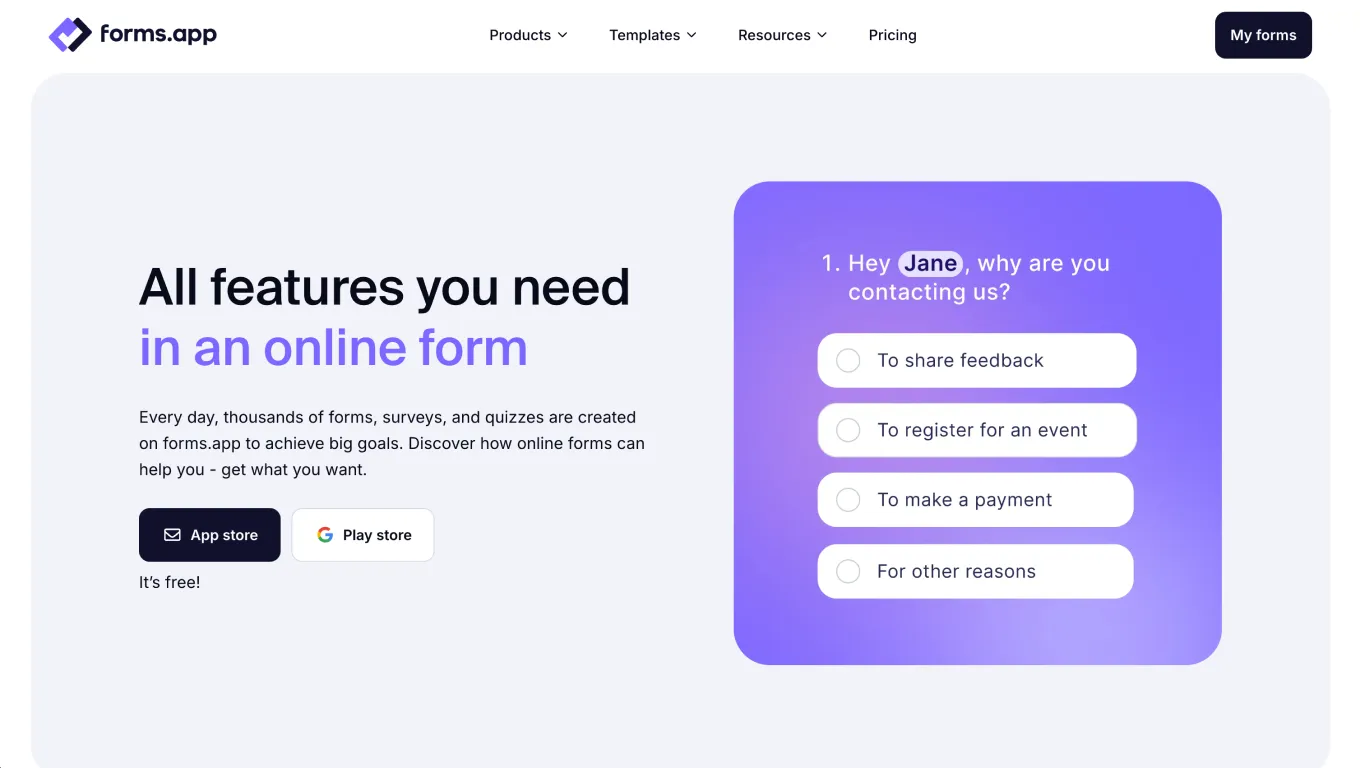
Features page of forms.app
5. Integrations
This section is important for every form builder because integrating with other apps will ease your management of form data and form submission phases. Jotform stands out with over 100 integrations, including popular tools like Google Sheets, Dropbox, Salesforce, and Mailchimp. It also connects with Zapier, simplifying workflow automation and data syncing across platforms.
Even that Microsoft Forms connects with Microsoft Suite, connecting with Microsoft Outlook, Onedrive, Microsoft Teams and other apps, it can be integrated with fewer applications than the other form-building platforms. Despite its solid integration within the Microsoft ecosystem, users may feel restricted when it comes to connecting with external tools and third-party apps.
| Integration | Jotform | Microsoft Forms | forms.app |
| Google Sheets | ✅ | ❌ | ✅ |
| Google Analytics | ✅ | ❌ | ✅ |
| Slack | ✅ | ❌ | ✅ |
| Mailshake | ✅ | ❌ | ❌ |
| WordPress | ✅ | ❌ | ✅ |
| HubSpot CRM | ✅ | ❌ | ✅ |
| PayPal | ✅ | ❌ | ✅ |
| Stripe | ✅ | ❌ | ✅ |
| Microsoft Excel | ✅ | ✅ | ✅ |
| Airtable | ✅ | ❌ | ✅ |
| Salesforce | ✅ | ❌ | ✅ |
| Pipedrive | ✅ | ❌ | ✅ |
6. Team collaboration
Jotform reviews can be made by team members at the same time, with strong key features of team collaboration, allowing users to share forms and manage submissions with their team. While its built-in collaboration tools are effective, integrations with apps like Slack, Google Drive, and Trello enhance team coordination and project management, facilitating smoother teamwork and more efficient form handling. However, in contrast to forms.app, Jotform doesn’t allow specific numbers of people to work on the same form in line with the type of the paid plan.
Microsoft Forms connects smoothly with Microsoft Teams and SharePoint, making it simple to share forms and work together within Microsoft 365. After creating a form, users can collaborate in real time with colleagues or professors so everyone can see each other's edits. The platform also allows you to share forms with specific people or anyone in your organization, making teamwork easier on the same document.
In forms.app, team collaboration becomes available from the Basic plan, which includes one additional team member. The Pro plan expands this to up to four members, enabling more dynamic teamwork for form creation and management. With the Premium plan, users can invite up to nine team members, offering enhanced collaboration for larger teams. This flexibility allows teams to work together efficiently, ensuring that form tasks and submissions are handled smoothly at every pricing level.
7. Templates
Jotform provides a vast selection of over 10,000 templates for various purposes, including surveys, registrations, and feedback forms. These templates are user-friendly and visually appealing, allowing you to easily customize them to fit your needs. This makes creating forms quick and straightforward.
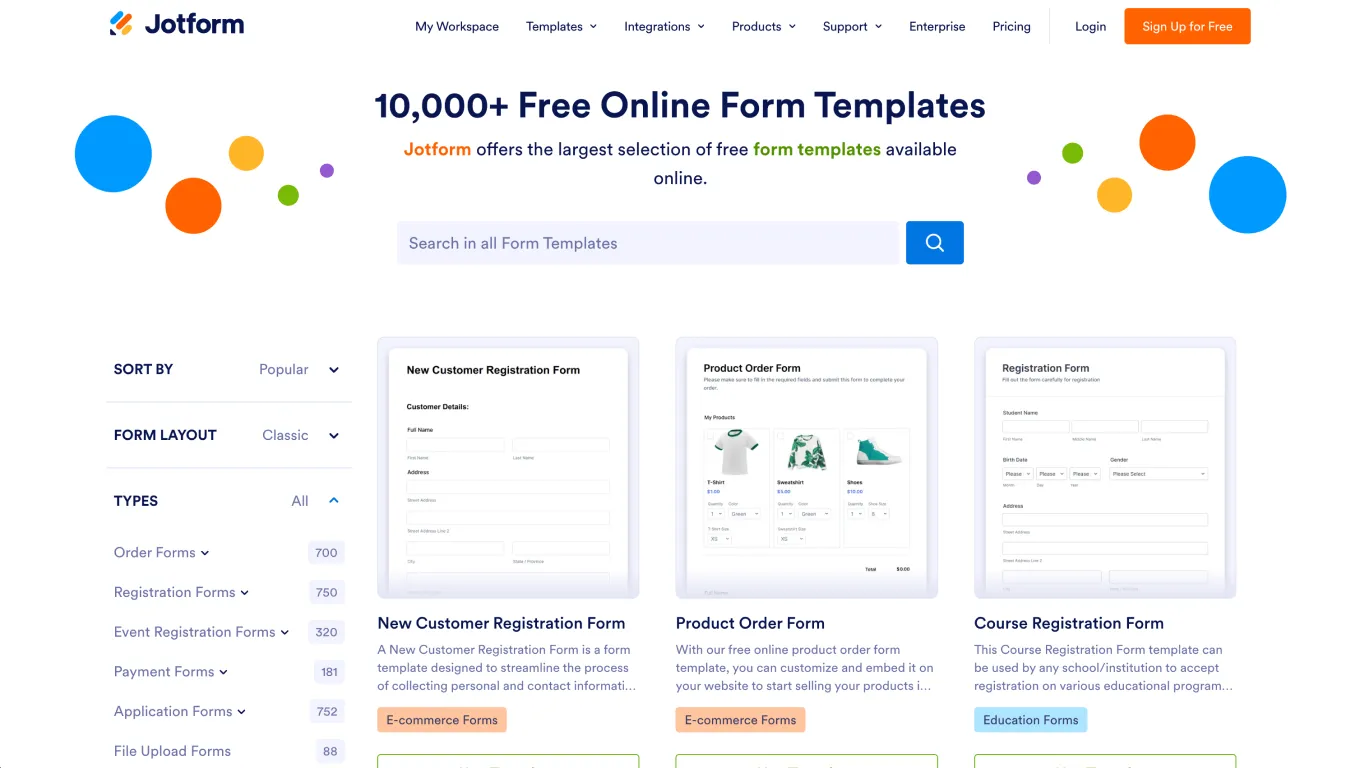
Template gallery of Jotform
Microsoft Forms has a smaller range of templates, more than 20, but they are still handy for simple forms, event registrations, and surveys. Keep in mind that each platform focuses on different needs with its templates.
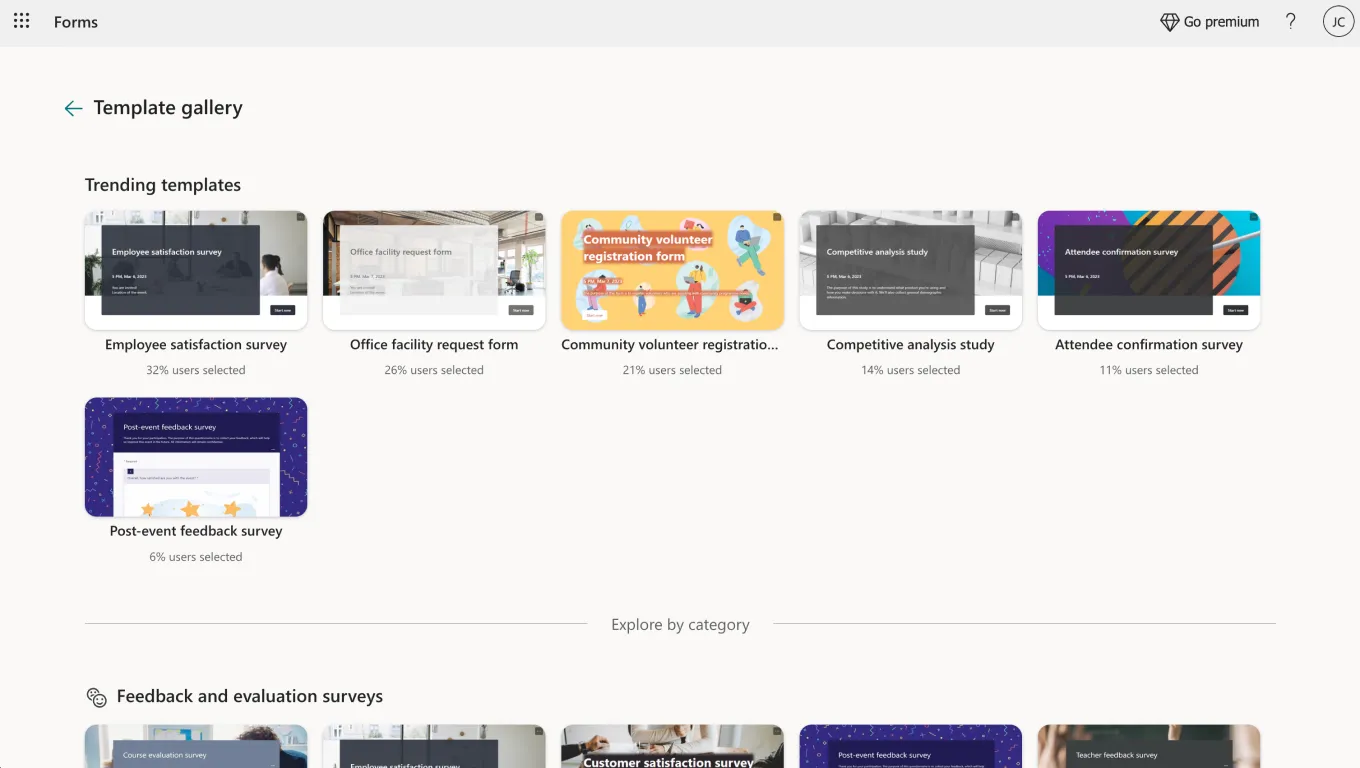
Template gallery of MS Forms
A better alternative: forms.app
After looking for different options, it’s clear that each tool has its own advantages and disadvantages. Some are great for customization but can be hard to use, while others are easier but don’t offer as many advanced features as the others. If you’re still unsure between Jotform and Microsoft Forms, you might want to consider a solid alternative: forms.app.
To check more pros of using forms.app, check out the list given below:
✔️ ⏳ User-friendly: Whether you're a pro or just starting out, forms.app has an easy drag-and-drop interface that makes creating forms a breeze, letting you have an improved customer feedback system. You can quickly get started and still achieve professional-looking results.
🤖🦾 Smart AI tools: The platform includes helpful AI features like the AI Form Generator, AI Survey Tool, and AI Quiz Maker. These tools use AI to speed up your work, saving you time and effort.
🧩🤝 Integrations: forms.app connects smoothly with popular apps like Slack, HubSpot, WordPress, Stripe, PayPal, and Google Drive. These integrations help your team stay productive and work efficiently.
📲🤳 Mobile app: You and your team can easily create forms on your mobile devices. There’s a dedicated app available on both Google Play and the App Store for form building on the go.
📚✨ Extensive template library: With over 5000 ready-made templates, forms.app has solutions for just about every need. The templates are organized by industry and purpose, making them easy to find.
Conclusion
Both Jotform and Microsoft Forms offer distinct advantages depending on your needs. Jotform offers robust customization and a wide range of integrations, making it an ideal choice for businesses with complex form requirements. Microsoft Forms, with its seamless integration into the Microsoft ecosystem, is ideal for businesses already using Microsoft products.
When selecting a form-building tool, it's essential to consider your specific needs and preferences. Jotform and Microsoft Forms both have their advantages, so knowing what you need will guide you to the right choice. On the other hand, forms.app provides a great blend of user-friendliness and advanced features, making it a flexible option for creating effective forms.
forms.app, your free form builder
- Unlimited views
- Unlimited questions
- Unlimited notifications
